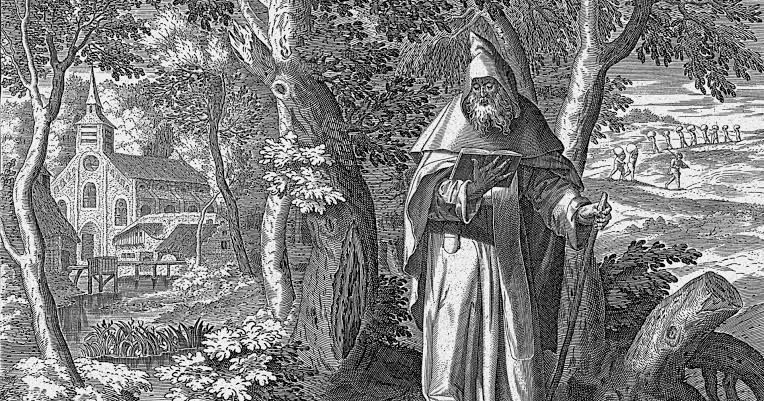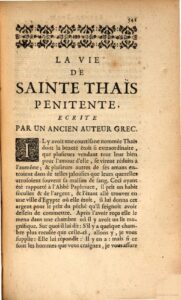Thaïs Online CourseSinner to Saint
While most female saints in religious hagiography were noteworthy for guarding their chastity, there are a few, Mary Magdalene being the most famous, who are venerated for having made an about-face in their life, from sinner to saint. Fourth-century Egypt gave rise to St. Thaïs, a minor saint whose feast day is celebrated on October 8. There is some doubt as to whether Thaïs was a real woman, or merely a fabrication designed to teach certain moral lessons, but her story is compelling, nonetheless.

St. Thaïs shares her name with a Greek woman from the 4th century B.C.E., Thaïs (probably of Athens), who was a courtesan or hetaira who accompanied Alexander the Great on his Persian campaign and may have later attained the status of Queen of Egypt. St. Thaïs was once a wealthy and extraordinarily beautiful courtesan in the city of Alexandria. Her popularity in Egyptian society was unparalleled, but to the Christian church she was a sinner. An ascetic monk, either St. Paphnutius, St. Bessarion or St. Serapion, travels from his monastic desert community to the city to bring Thaïs to salvation. When she accepts the gospel of Christianity, she burns all her possessions and retreats to the desert to join a community of nuns. Thaïs is sealed into a convent cell for three years as penance, as suffering was typically considered a path to purification. When she is deemed worthy to emerge, freed from her former life, she only lives in the community for 15 days before her death. In 1901, Egyptologist Albert Gayet discovered the mummified remains of a man and a woman. Initially they were exhibited as the corpses of Sts. Thaïs and Serapion, but Gayet later walked back his claims as to their identity.

The legend of St. Thaïs occurs in Orthodox lore as well, with a few differences. In the Orthodox version, Thaïs was a wealthy orphan who was determined to share her good fortune with the poor. When she ran out of funds, she was determined to obtain wealth by any means, and descended into a life of sin. The Thaïs story existed in early days in Greek, Latin, and Syriac language versions, but the most “definitive” version was included in Lives of the Fathers (Vitae Patrum), a collection of tales of desert hermits and ascetics. The tenth-century canoness Hrotsvitha of Gandersheim penned several plays on religious themes, one of which was a Latin play called Pafnutius. When Pafnutius brings Thaïs to the convent for penance, he introduces her to the abbess in this manner:
I have brought you a half-dead little she-goat, recently snatched from the teeth of wolves. I hope that by your compassion its shelter will be insured, and that by your care, it will be cured, and that having cast aside the rough pelt of a goat, she will be clothed with the soft wool of the lamb.
Anatole France’s 1890 version of the Thaïs legend is the most direct source material for Massenet’s opera. Anatole France was a journalist, poet, and novelist active between approximately 1867-1924. The son of a bookseller, he lived most of his life among books, as a writer, cataloguer of writings, and librarian. He was awarded the 1921 Nobel Prize for Literature for his contributions to the literary community. In 1922 his entire literary oeuvre was added to the Catholic church’s list of prohibited writings where it remained until the list was abolished in 1966. France was known for his acerbic and satiric writings which were decidedly anti-religion and anti-Christian. His most influential novel was 1914’s The Revolt of Angels, which tells the story of angel Arcade’s questioning of his faith which leads him to atheism and humanism.
At the age of 22, Anatole first became fascinated by the story of Thaïs as told in Les vies des Saints, as well as Hrotsvitha’s version. In 1888, his passionate affair with Léontine Arman de Caillavet, an artistic “muse,” brought him back to this subject. Thaïs was published in 1890, and tells the story from the perspective of Paphnuce (the Gallicized name for Paphnutius), relating his quest to save the soul of Thaïs, subsequently losing his own faith in the process. Is it a story of the triumph of faith over flesh, or a “nihilistic” tirade against denial of one’s natural human impulses? While we might not be able to decide unequivocably which message we want to take away, there is no doubt that Massenet treated this story with lyricism and affection.


In addition to the operatic version, France’s novel Thaïs inspired a 1911 Broadway play, a 1917 silent film starring opera star Mary Garden, and a satirical synopsis by the witty poet Newman Levy, published in a 1923 volume entitled Opera Guyed.
“One time in Alexandria, in wicked Alexandria
Where nights were wild with revelry and life was but a game
There lived, so the report is, an adventuress and a courtesan
The pride of Alexandria, and Thaïs was her name.”
from Opera Guyed







